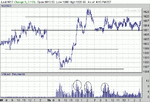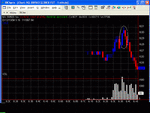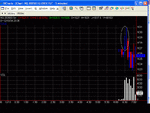Sulong's chart provides a good example of an issue that has arisen more than once regarding the work I've done with price action and may help explain why some people have so much trouble with this stuff.
As I point out in the testing section of the PV😛racticum, there are several "keys" or "concepts" or whatever one wants to call them that one must keep in mind in order to succeed with this approach:
Demand/Supply
Price/Volume
Support/Resistance
Trend
Breakouts/Retracements/Reversals
The Law of Demand/Supply is absolute in an auction market. Without it, there is no market. Support/Resistance and Trend are not absolute but are axiomatic with regard to this approach, in other words, one must accept the concept that there are such things as support, resistance and trend when studying this approach, much less attempting to apply it, or else the whole thing unravels. If one believes instead that there are no such things as support and resistance, that there is no such thing as trend, then this is all a waste of time.
Sulong's chart provides one of the best examples of support and resistance I've seen lately (in fact, I saved it yesterday to include in the next pdf since it also includes a springboard and a hinge), and anyone who accepts S/R as axiomatic will ooh and aah; anyone who thinks that S/R is a load will assert that it's all just an anomaly and of no practical and/or applicable use. What is important, though, is not the issue of proof (which is why I chose the term "axiomatic") but of whether or not one can do something with this, i.e., can one find multiple examples of this sort of thing in old charts and find tradeable characteristics with regard to breakouts, reversals, and retracements. If he can't, then none of this is of any use to him whatsoever. That does not mean, however, that it is of no use to anyone. Someone else, e.g., Darvas, might find something very tradeable and find success with it as a result.
Therefore, if one cannot at least keep an open mind with regard to abovementioned axioms when studying these charts, he may as well move on to something else: there is no proof offered here. However, if one can keep that open mind, even though he may not yet be a member of the choir, this chart provides an excellent example (though not the only example by any means) of what to look for.



